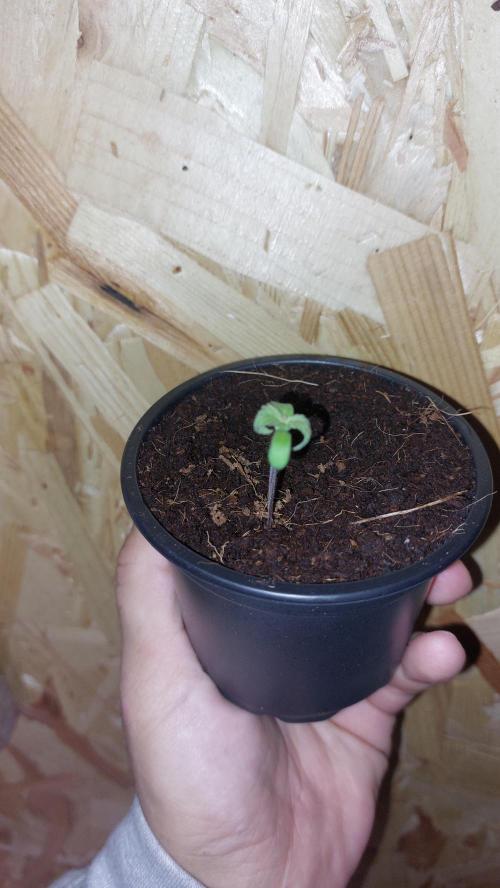The Grow Awards 2026 🏆
How do I find out ppfd for a grow light please? Se...
Shazzabeestarted grow question 3mo ago
How do I find out ppfd for a grow light please? Seedlings are 7 days post germination.
Light is an Adjusta-Watt 720W
Retro LED set to 250W
States 1890 PPF at 15cm off canopy at 720W
Light is currently 30cm from canopy as they seemed to be stretching first few days when 60cm off
Solved
likes
00110001001001111Oanswered grow question 3mo ago
In this context, you are better off just using trial and error. If it stretches too much, you need more. If it stays too tight, need less.
Not sure if the droopiness seen is the lack of aeration in the medium or too much light... you want 50% of volume in a heavy soil to be perlite or equivalent. In a lighter medium, like coco, only need 33% perlite or equivalent amendment. Makes drowing roots impossible... in which case you'd know any droop is caused by something else.. one less thing to consider makes diagnosing easier.
if the leaves bunch up (too tight node spacing), they start to push on each other - upward.. it looks funky and unnatural. That's not the threshold.. that's when it is really bad for a fairly long time. Make sure some node spacing develops over time.
Take notes of timing... and adjust what you did this time to do better next time.. since you only have a week or two to fine-tun it before it demands a normal amount of light, it may take a cycle or two to really dial it in perfectly. Notes will help as it'll be 3-4 months from now when you do it again. power and distance...
---------- below are suggestions and how to handle the light when covering the full tent... much easier to provide a suggestion. The spec sheet does not list model of diode and their numbers don't add up, so some information may need to be gathered from the light manufacturer to give better starting recommendations.
Consider buying a 50w light. Maybe a 100-150w that you can use from seedling into early mature vege before the plants take up more space -- just depends on how many seedlings you have, when you put up etc.... It'll be considerably easier to dial in power and hanging distance than a huge light and a few seedlings.
reduces wear-n-tear on your expensive light.. saves electricity, saves heat, generally easier to calculate a better starting point for power of light etc etc...
----
As far as a more orthodox context of mature plants and "full" DLI applied to roughly the whole tent, using math is easier and reduces trial and error --- still have the same trial and error methods as above, but much more accurate to start.
With ambient CO2, work backward from 37 DLI. Working it out based on 12 hour operation ensures your light has enough oomph, but you'll be doing any trial and error in vege phase with 18h operation. 18h operation is merely 2/3rds of the power needed for 12h operation.
Again, just a ballpark to start... actual growth is your guide to adjusting power. Hanging distance should remain the same because it's providing best coverage wall-to-wall and the geometry isn't changing.
This light is too much for a 4x4 but a hair too low for a 5x5. I don't trust the spec sheet based on .36w per diode and no mention of which model diode. Efficacy is unlikely to be 2.7umol/J. I'd wager it's closer to 2.3-2.5 umol/J range, which gives it a max output of ~1800umol/s. NEarly every lightmanufacturer fibs on the spec sheet. Need to compare to diode manufacturer testing paramaters to weed out the bullshit.
For 12 hours and 37dli, it's roughly 80umol/s per sq ft. so, 1800umol/s covers about 22.5 sq ft. this a little over 2m^2. (2.093m^2). This is your max coverage with photoperiods. With autos, you can cover 1.5x more area assuming you can hang the light high enough and get proper spread of light wall-to-wall. Because these lights tend to be designed for 12h requirements, might need to accept less than theoretical 1.5x more area for decent coverage as the frame will be fairly under-sized.
This all assumes a properly sized light and proper hanging distance for best coverage across canopy without sacrificing overall average.
Like i said, this is caclulate to see max requirements... assuming you cover 22.5sq ft, you run it at 67% over 18h .. make your adjustments based on plant growth... when you have it fine-tuned, there is no more trial and error. If you settled on 60%, then you'll want 90% over 12h (150% more). Anything over 67% required during 18h means you have an under-powered light for the area of coverage and you won't be able to match the same DLI without more light. (i.e. 67% x 1.5 = 100% ... can't go over 100%, obviously)
If you are working a smaller area, let's say a 4x4 tent, you start at a proportionally lower point.
16 / 22.5 = 71% for 12h. Then same math as above to convert to 18h - 71 *.67 = about 48% is your starting point for 18h operation in a 4x4 with mature plants. Work out hanging distance the same as above -- strong in corners/sides without sacrificing overall average. You can use klux or photone app.. doesn't matter as it's about proportional differences from center to corner. 50% of center is still 50% of center reading regardless of lumens or umol/s values.
You start at 48% covering entire 4x4... let's say you settle on the growth that occurs with 45%. when you flip to 12/12, you simply crank it up to 67.5% (48*1.5) and you are giving same DLI as you did over 18h and there should be no adjustments needed from there as you already worked it out in vege.
With seedlings, your frame is larger than the intended coverage, lol. you are using wonky hanging distances... you simply have to rely on trial and error. Calculation in this context will be lacking.
buy a smaller light for seedlings and early vege... it's worth it.
John_Krameranswered grow question 3mo ago
P deficiency
Also could be Ca
Ps it,s not the light that cause curling, it,s hunger
likes
Complain
HandsomeTerpzanswered grow question 3mo ago
Hey Hope It helps
____________________
Phase
| PPFD Range (µmol/m²/s) | DLI Range (mol/m²/day)
---------------------------------------------------------------
Seedling
| 100–300
| 6–15
Vegetative
| 300–600
| 15–30
Early Flower
| 600–900
| 30–40
Mid/Late Flower | 900–1200
| 40–60
In the mid to late flowering stage, PPFD values of 900–1200 µmol/m²/s can be considered quite high for many strains. While some genetics can handle this intensity well, others may show stress symptoms such as light burn or nutrient imbalances if not managed properly. To make use of such high light levels efficiently, the plant often needs additional nitrogen and balanced nutrition, since photosynthesis and energy demand are much higher.
🙂
1 like
Complain
00110001001001111Oanswered grow question 3mo ago
"put up" = pot up... "transplant" is a bit more than just potting up.
likes
Complain
Grow4Releafanswered grow question 3mo ago
U can try an app on ur phone aswell. I use a app "ppfd meter" with a Bluetooth meter made by UNI-T. Works well instead of guessing where my lights are set now. Photone is another app ppl use but if using a phone it's not going to be 100% accurate but combo with watching the plant it can help. Good luck with it !
1 like
Complain
BernMarsanswered grow question 3mo ago
The manufacturer should be giving you specs for a traditional grow light. Using other lights as grow lights makes it harder to figure out. I liked using a photometer app on my smart phone for a while, and easing plants into full daylight levels, which you can find on google
1 like
Complain







